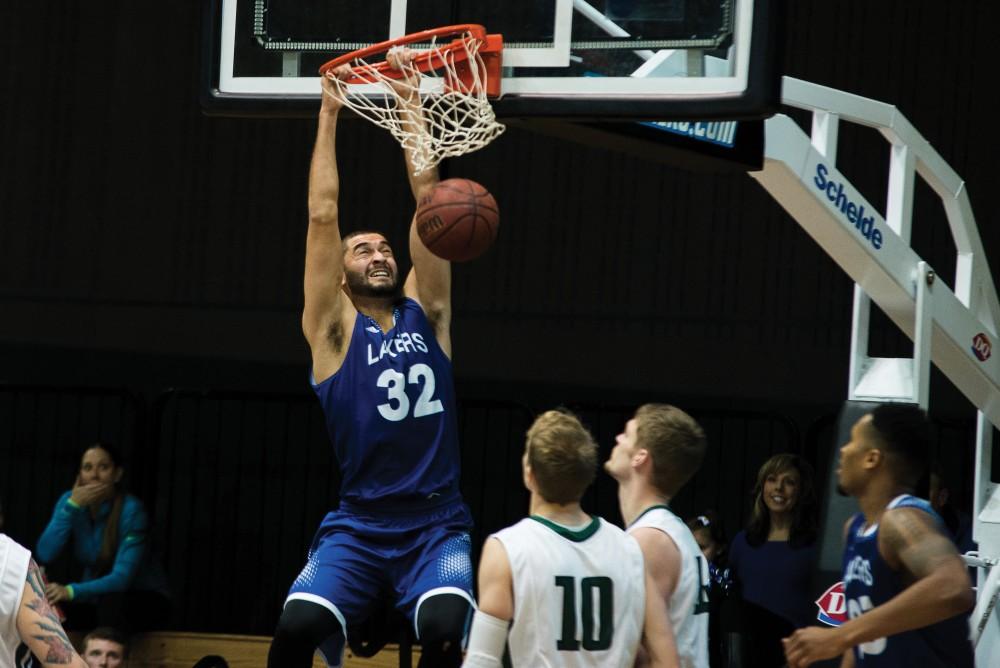GVSU forward expands game, shines for Lakers

GVL/Luke Holmes Ricardo Carbajal (no.32) slams the ball down for the dunk. The Lakers lost to Lake Erie College 78-84 on Dec. 5.
Jan 14, 2016
Ricardo Carbajal used to speak nothing but Spanish. He used to play offense with his back exclusively to the basket. For a season, he hooped at Quincy University.
Now Carbajal speaks English without a trace of an accent. He can handle the ball in the open court, or spot up for a jumper. He’s a Grand Valley State basketball player, through and through.
“When he first got here, he had some injury problems that probably slowed him up a little bit and then each year he’s become more and more consistent in his game,” said GVSU head coach Ric Wesley. “Each year he’s gotten more and more confident, more and more consistent. He’s certainly expanded his game in terms of shooting and ball-handling.”
Carbajal, a fifth-year senior, transferred to GVSU after one injury-shortened season at Quincy. The 6-foot-6-inch combo forward arrived in Allendale and made an impact immediately in his redshirt freshman campaign.
Over the next few years, he progressed. His game sprouted new branches. Teammates came, went and improved with him. On Jan. 3 in an 82-66 loss at Findlay, Carbajal netted his 1,000 career point as a Laker, becoming the 33rd player to accomplish the feat.
Were it not for strong family ties, Carbajal may have only stepped into Fieldhouse Arena with hopes of beating the Lakers.
Coming out of Munster High School, Carbajal signed to play at Quincy, about five driving hours from Munster, Indiana. It quickly became apparent Quincy wasn’t the right fit. Carbajal transferred after one season, and ended up at GVSU, a mere two-and-a-half hours from home.
“I wasn’t really happy at Quincy,” Carbajal said. “I liked the coaches, the team, but it was my first year in college and was way too far from home. I got hurt and it disconnected me with the rest of the team.”
A slew of injuries to teammates during his freshman year at GVSU afforded Carbajal the opportunity to make an immediate impact. He did, and his numbers have steadily climbed each season.
Last season, Carbajal’s best, he was named to the All-GLIAC Second Team and was just one of four Lakers to play in all 28 games. He led GVSU in points, rebounds, free throws made and attempted, steals and field goal percentage.
More minutes clearly contributed to Carbajal’s statistical improvements. His ability to adapt to a new, quicker game was perhaps more important.
“When I got to college I knew I had to expand my game,” he said. “I was dominant in high school down low, there weren’t that many people way bigger than me in high school.
“I’ve always wanted to shoot and stuff. I practiced my ball-handling, shooting and every year I just increased my range. I only shot a couple of jump shots in high schools, now in college I just worked hard on it and expanded my range.”
Always a tricky, effective scorer at the rim, Carbajal now has the ability to step out on the baseline or elbow and knock down jumpers. Through 15 games in the 2015-16 season, Carbajal is shooting .513 percent from the field, and has even made four 3-pointers, rounding out to 9.9 points per game.
“Nobody embraces the bumping and grinding and toughness around the basket, it’s almost like a cultural thing,” Wesley said. “There’s certainly still a place for guys who can score with their back to the basket, but more and more kids don’t only want to only hang their hat on that.
“Early in the career, (Carbajal’s) ability to score around the basket was probably what made him an effective player, and now the natural progression moving outside is one that’s much better than the opposite way. He’s progressed in the way you want to see a lot of kids progress.”
While the ability for a forward to stretch to the outside isn’t rare in today’s basketball, Carbajal’s cultural background is as unique as it gets.
Though born in the United States, Carbajal comes from direct Mexican heritage, as his parents are Mexican natives. With soccer taking the majority of Mexican athletes, basketball has never been a priority to the United States’ southwestern cousin.
Carbajal’s heritage qualifies him to compete for Mexican national teams in international events. In 2011, he was invited to play for the Mexican national U18 team. Due to safety concerns in Mexico at the time, Carbajal didn’t travel to training camp to practice with the team. When he arrived at a U18 tournament in San Antonio, the Mexican national coach didn’t let Carbajal play due to his absence at camp.
Carbajal watched from the bench at Kyrie Irving and the U.S. team gashed Mexico in a blowout win.
Carbajal has since met with the Mexican Olympic coach, and is happy to keep his options open once his college career ends. For now, however, his Mexican heritage and its connection to basketball manifests itself in joking around with his family.
“My family itself, like there’s nobody athletic in my family. I always joke around with my parents like, ‘If you guys even had a little bit of athleticism I could be such a better basketball player,'” Carbajal said. “My dad loved watching (Michael Jordan) in the 90s, but there’s no one in my family that plays basketball.”
But Ricardo Carbajal plays basketball, and he plays it well. He has started 12 of 15 games for the 12-3 Lakers and ranks among the team leaders in points and rebounds per game.
His Spanish language abilities still bounce around in his brain. His jump hook and drop step are still effective. But now, he’s happy as a Laker.

























